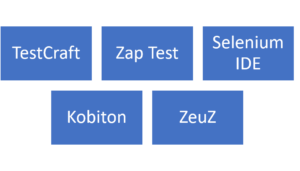In the fast-paced world of technology, scriptless test automation is essential to ensuring successful delivery. Automation testing is designed to reduce the manual testing efforts and provide wider testing coverage, resulting in accelerated deployment timelines and increased quality of deliverables. By automating the test cases and user stories, you can significantly accelerate the testing process. Everyone in the tech industry, from boutique firms to large enterprises, is adopting the test automation approach to achieve higher levels of quality.
What is Scriptless Test Automation?
Scriptless test automation is a tool that helps the user to automate test cases without in-depth knowledge of the code. The creation of the test is focused on validating the business logic. Minimal human efforts are required to create a test case – instead of writing the code user just needs to indicate which step needs to be performed next. The automation tool translates the steps into the actual code in the background during the test execution. Thus, the end result can be achieved in significantly less time.
Why Use Scriptless Test Automation?
Scriptless test automation is gaining popularity because it helps the quality assurance team to quickly create and customize automated test cases. It also increases reusability of the code to provide 100% test coverage.
The word “scriptless” is coined for no-code or no-programming. People often assume that no programming knowledge is required, but on the contrary, the scriptless testing framework is an immensely versatile framework that requires very basic knowledge of the code. The major advantage of using such a framework is that it reduces the time required to produce the automated tests as well as saving the scripting efforts.
Any scriptless automation tool is a highly customized and categorized instrument which can be used in real-time test structures. The team responsible for the development of such tools analyzes all of the possible aspects like the user stories, environments, working structure, etc., so that the deployed piece of code for the tool can maintain its key property i.e. reusability.
Anatomy of a Scriptless Test Automation Framework
Let’s take a look inside a scriptless test automation Framework:

The diagram above represents the high-level architecture of scriptless test automation. It consists of three important parts, the Frameworks Brain, the Input, and the Output Module.
Let’s break down the core functionality of each module:
- Frameworks Brain: This is the most important part of the framework. It does all of the major tasks like automating the logic, validation, checking the integration with rest of the components, and taking all of the third-party applications into consideration.
- Input Module: This is the point where the user provides the test inputs such as Test Steps, Conditions, Setup Data, Expected Results, etc. The input components also include the interpreter which follows some algorithms to pass the information to the Frameworks Brain.
- Output Module: This component is basically the result and it can take a variety of different forms. For example, logs, results, reports, as well as dashboards would all be outputs.
Debunking Scriptless Automation Testing Myths
There are many misconceptions about scriptless automation testing that cause some organizations to be more hesitant to adopt it into their testing process. Let’s take a deeper look at some of the common myths surrounding test automation.
No Scripts are required
Because the automation framework is extremely user-friendly, people assume that code isn’t required. On the contrary, you should possess basic coding knowledge, at least, to incorporate automation into the testing process. It is true, however, that those who use the tool will generally never need to look under the complex code structure.
Record and Play is the only feature of test automation
This is false, as test automation tools include many features like dynamic elements assertion, conditional checks, easy assertions, etc. that are much more advanced than simply record and playback. The major drawback of using the record and tool is that it cannot handle dynamic requests and the inputs are usually hard coded. This problem can be easily corrected with a scriptless automation tool because it is much more efficient with exception handling.
Scriptless automation is not authentic and is difficult to maintain
On the contrary, the automation framework has an incredibly flexible structure and changes are easily incorporated into the framework. It also provides a key traceability feature which increases transparency by helping the user to monitor all the changes and updates happening on the framework.
Tools available for Scriptless Test Automation
There are many tools available for scriptless automation testing. Some of the most popular tools within the industry are TestCraft, Zap Test, Selenium IDE, Kobiton, and Zeuz.

As the world moves towards the Agile process, scriptless test automation is the perfect tool to accelerate the development of automated tests. Incorporating it into the testing process saves a significant amount of time and money reduces the efforts for maintaining the test cases considerably. It also comes up with many unique features which have improve the process of designing the framework. So, when the deadlines are on crunch and you need to ensure the highest level of quality delivery, scriptless test automation is the perfect solution.


Useful Info.
Thank you for sharing Hrudesh! It is quite informative.
Great article! Brings lot unknown insights about scriptless automation to light for users